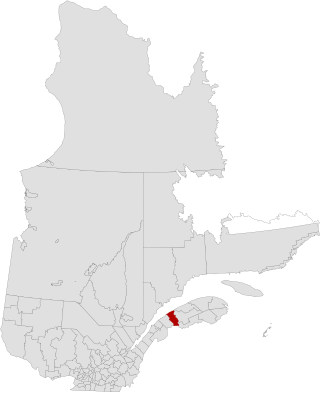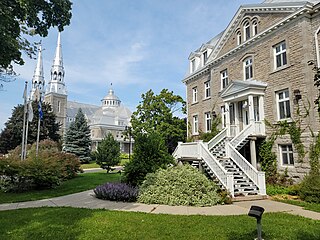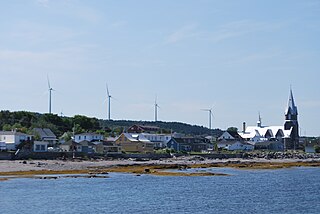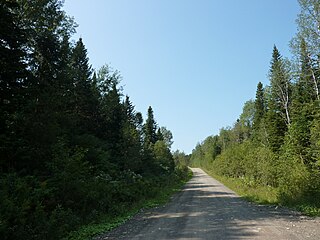The Mitis Seignory (French : seigneurie de Mitis) is a forest and wildlife territory located in La Mitis Regional County Municipality in eastern Quebec. It was a seignory during the French colonisation of New France.
The Mitis Seignory (French : seigneurie de Mitis) is a forest and wildlife territory located in La Mitis Regional County Municipality in eastern Quebec. It was a seignory during the French colonisation of New France.
The Mitis Seignory was first granted to Jean-Baptiste de Peiras by the New France's governor, Louis de Buade de Frontenac, on May 6, 1675. [1]
The Scottish Mathew MacNider acquired the seignory in 1802 and his brother, John MacNider, bought it in 1807. [2] In fact the MacNider family was the owner of the Mitis Seignory for almost 50 years. [3]
At the time of its granting in 1675 the territory of the seignory measured two leagues along the Saint Lawrence River by two leagues away from the river. [4] It is entirely included inside La Mitis Regional County Municipality in Bas-Saint-Laurent.

La Mitis is a regional county municipality in the Bas-Saint-Laurent region in eastern Quebec, Canada on the Gaspé peninsula. It is named for the Mitis River which has its source in the region and flows through the central part of the region before emptying into the Saint Lawrence River.

Varennes is an off-island suburb of Montreal, in southwestern Quebec, Canada, on the Saint Lawrence River in the Marguerite-D'Youville Regional County Municipality. The city is approximately 24 kilometres (15

Métis-sur-Mer is a city in the La Mitis Regional County Municipality within the Bas-Saint-Laurent region of Quebec, Canada. It had a population of 594 in the Canada 2021 Census.

Grand-Métis is a municipality in the La Mitis Regional County Municipality within the Bas-Saint-Laurent region of Quebec, Canada. It is situated where the Mitis River meets the Saint Lawrence River, and was developed from 1818 by the pioneering John MacNider.

Saint-Antoine-de-Tilly is a municipality in the Lotbinière Regional County Municipality in Quebec, Canada. It is part of the Chaudière-Appalaches region and had a population is 1,682 as of 2021.

Baie-des-Sables is a municipality in La Matanie Regional County Municipality in the Bas-Saint-Laurent region of Quebec, Canada.

The Matapedia Valley was formed by the Chic-Choc Mountains of eastern Québec. Its name is derived from the river that traverses the valley, as well as the lake that lies in its center. It is situated in the southwest of the Gaspé Peninsula and stretches 375 km (233 mi).

Batiscan is a municipality in the Mauricie region of the province of Quebec in Canada. It is located along the St Lawrence River at the mouth of the Batiscan River.

Portneuf is a municipality in the Portneuf Regional County Municipality, in the province of Quebec, Canada. It is located on the Saint Lawrence River, between Quebec City and Trois-Rivières. The Portneuf River runs on the east side of the town centre.

La Visitation-de-l'Île-Dupas is a municipality in the Lanaudière region of Quebec, Canada, part of the D'Autray Regional County Municipality. Its territory is located on several of the Sorel Islands in the Saint Lawrence River where it flows into Lac Saint-Pierre. The largest of these islands is Dupas Island, also known as Isle du Pads, Île d'Angoulème, and Île du Richelieu at various times in the past.

Saint-Joseph-de-Lepage is a parish municipality in La Mitis Regional County Municipality in the Bas-Saint-Laurent region of Quebec, Canada.

Sainte-Luce is a municipality in the La Mitis Regional County Municipality in the Bas-Saint-Laurent region of Quebec, Canada. The population in the Canada 2021 Census was 2,845.

The seignory of Lac-Matapédia is a forest land located on the north shore of Lake Matapédia in the Matapédia Valley in the unorganized territory of Lac-Matapédia, in Amqui, and in Sayabec, in the La Matapédia Regional County Municipality, in administrative region of Bas-Saint-Laurent, Quebec, Canada. The territory is under a "forest supply and management contract" with the Ministry of Natural Resources and Wildlife (Quebec). It is also the regional Park of Lac-Matapédia.
The Lessard Seignory was a seignory during the French colonisation of New France. It was located in the present-day Rimouski-Neigette Regional County Municipality in Bas-Saint-Laurent.
The seignory of Bic was a seignory during the French colonisation of New France. It was located in present Rimouski-Neigette Regional County Municipality in Bas-Saint-Laurent.
The seignory of Lac-Mitis was a seignory during the French colonisation of New France. It was located in present-day La Mitis Regional County Municipality in Bas-Saint-Laurent. It was granted to Louis Rouer de Villeray by Louis de Buade de Frontenac, the governor of New France, on February 10, 1693.
The Madawaska Seignory was a seignory during the French colonisation of New France. It was located in present-day Témiscouata Regional County Municipality in Bas-Saint-Laurent.
The Rimouski Seignory was a seignory during the French colonisation of New France. It was located in the present-day Rimouski-Neigette Regional County Municipality in Bas-Saint-Laurent, Quebec.

The Mitis River is a salmon river in the Bas-Saint-Laurent region of Quebec, Canada. It flows to the south shore of the Saint Lawrence River. There are two hydroelectric dams on the river at a point where a waterfall used to prevent salmon from going further upstream. A system to capture and transport salmon upstream was installed in 1965, and the river now has a healthy salmon population along its whole length.

The lordship of Lac-des-Deux-Montagnes was a seigneury in New France. It was located in the current regional county municipality of Deux-Montagnes Regional County Municipality in the administrative region of Laurentides in Quebec (Canada).